Exploring Accuracy in Measurements
What is Accuracy?
Accuracy is the extent to which a measurement aligns with its true value. It defines precision and correctness in measurement contexts.
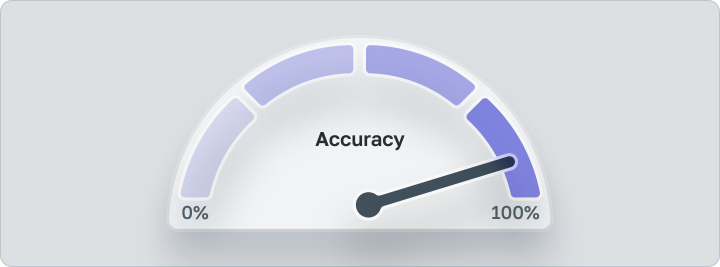
It indicates the correctness and reliability of measurements, reflecting how well the measurement reflects the actual quantity being measured. Achieving accuracy involves minimizing systematic errors and ensuring that measurements are as close to the true value as possible.
Accuracy is crucial for obtaining reliable data, making informed decisions, and maintaining quality standards across various fields, including science, engineering, healthcare, finance, and manufacturing.
Importance of Accuracy
Accuracy is critical in various industries for several reasons:
- In healthcare, accurate medical diagnoses ensure proper treatment and patient safety.
- In manufacturing, accurate measurements are essential for maintaining product quality and meeting specifications.
- In finance, accurate market data is crucial for making informed investment decisions and managing risks effectively.
- In scientific research, accurate measurements are fundamental for generating reliable data and drawing valid conclusions.
Across all sectors, accuracy underpins decision-making, regulatory compliance, and maintaining trust and credibility with stakeholders, making it indispensable for ensuring the integrity and success of operations in various industries.
Factors Affecting Accuracy
Factors affecting accuracy include instrument calibration, environmental conditions, human error, sampling techniques, and data processing methods.
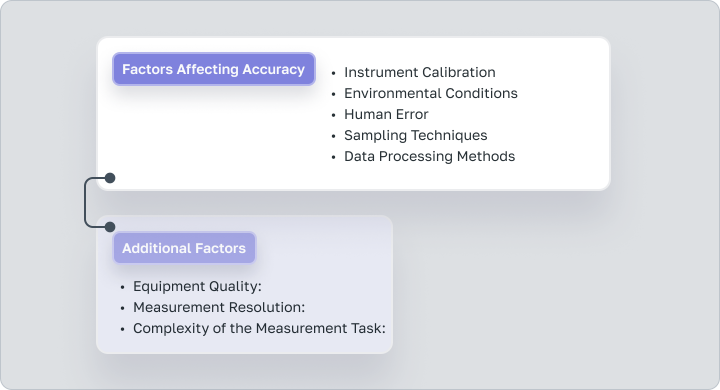
- Instrument Calibration Proper calibration ensures that measurement instruments are aligned to known standards, minimizing systematic errors and ensuring accuracy in readings.
- Environmental Conditions Variations in temperature, humidity, pressure, and other environmental factors can introduce errors in measurements, affecting accuracy. Controlling environmental conditions or applying correction factors can mitigate these effects.
- Human Error Mistakes made by operators during measurement, such as misreading instruments or improper technique, can lead to inaccuracies. Training, supervision, and implementing standard operating procedures can reduce human error.
- Sampling Techniques Inappropriate sampling techniques may lead to biased or incomplete data.
- Data Processing Methods The way data is collected, recorded, and analyzed. Errors in data processing, such as incorrect calculations or data entry mistakes, can result in inaccurate conclusions.
Additionally, equipment quality, measurement resolution, and the complexity of the measurement task can impact it.
- Equipment Quality The measurement instruments and equipment can vary based on their quality.
- Measurement Resolution The smallest increment that can be measured by an instrument. Higher resolution allows for more precise measurements.
- Complexity of the Measurement Task Some measurements are inherently more complex and prone to errors than others. Complex tasks may require additional precautions or sophisticated measurement techniques.
Examples of Accuracy in Practice
Accuracy is critical:
- In IT, software development ensures that codes and algorithms perform as intended, preventing errors and vulnerabilities.
- In marketing, accurate data analysis informs strategic decisions, targeting the right audience and maximizing ROI.
- In architecture and construction, accurate measurements and blueprints are essential for building structures according to specifications.
- In production, accurate inventory management ensures efficient supply chain operations and prevents stockouts or overstock situations.
Delving into Precision in Measurements
What is Precision?
Precision, in the context of measurements, refers to the degree of consistency or reproducibility of results obtained from repeated trials or measurements. It reflects the degree of agreement among individual measurements.
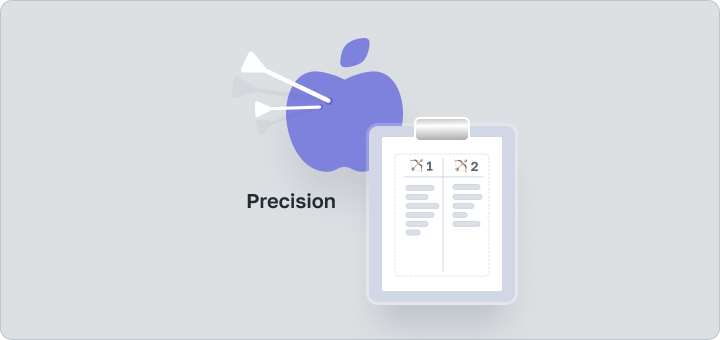
Unlike accuracy, which measures how close a measurement is to the true value, precision focuses solely on the variability or scatter among measurements. It measures the extent to which repeated measurements yield similar results, irrespective of whether those results are accurate or not.
Achieving high precision involves minimizing random errors and ensuring that measurements are reliably reproducible under consistent conditions.
The Role of Precision
Precision plays a vital role in measurements by ensuring consistency, reproducibility, and reliability of results. It allows for the detection of subtle changes or differences in data, aiding in quality control and process optimization.
Precise measurements reduce variability, enabling better comparisons between samples or experiments. In fields such as manufacturing, engineering, and scientific research, this concept is crucial for maintaining product quality, validating hypotheses, and advancing knowledge.
Moreover, precise measurements contribute to improved accuracy over time, as they help identify and minimize sources of error, ultimately enhancing the overall reliability and utility of measurement data.
Factors Influencing Precision
Factors influencing precision include:
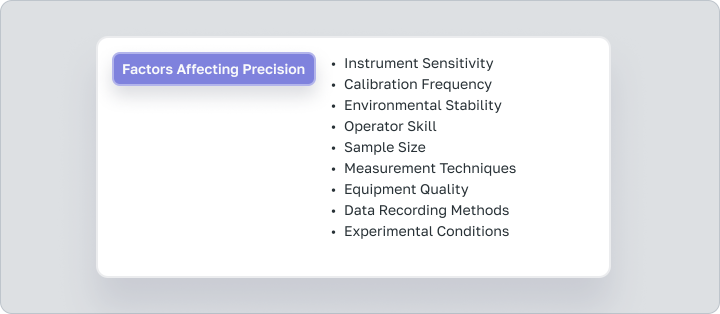
- Instrument Sensitivity Instruments with higher sensitivity can detect smaller changes in measurements.
- Calibration Frequency Regular calibration ensures that instruments maintain their accuracy over time, minimizing drift and variability in measurements.
- Environmental Stability Stable environmental conditions, such as temperature and humidity, reduce fluctuations that could introduce errors.
- Operator Skill Skilled operators are better able to perform measurements consistently and accurately.
- Sample Size Larger sample sizes generally lead to more precise measurements, as they reduce the impact of random variations or outliers.
- Measurement Techniques Well-established and standardized techniques tend to yield more precise results.
- Equipment Quality Higher-quality equipment typically provides more precise measurements due to better construction, materials, and design.
- Data Recording Methods Accurate and consistent data recording methods are essential for maintaining precision. Errors or inconsistencies in data recording can introduce variability and reduce precision.
- Experimental Conditions Variations in experimental conditions, such as lighting, humidity, or equipment setup, can influence precision. Controlling these factors helps maintain consistency and precision in measurements.
Precision in Various Contexts
- In IT, it is essential for writing code with consistent syntax and minimizing bugs, ensuring smooth software operation.
- In marketing, precise targeting of specific demographics maximizes campaign effectiveness and minimizes wasted resources.
- In architecture and construction, precision in measurements and craftsmanship ensures structural integrity and aesthetic appeal.
- In production, machining and assembly techniques yield high-quality products with minimal defects, enhancing customer satisfaction and brand reputation.
What is the difference between accuracy and precision?
Key Differences
Accuracy and Precision have some crucial characteristics that lies in what each concept measures and shows what’s the difference between accuracy and precision.
 Correctness and reliability
Correctness and reliability
Accuracy refers to how close a measured value is to the true or accepted value, indicating correctness and reliability.
![]()
 Central value
Central value
Precision, on the other hand, measures the degree of consistency or reproducibility of measurements, reflecting how tightly clustered individual measurements are around a central value.

![]() Correctness vs consistency
Correctness vs consistency
In essence, the first concept assesses correctness, while the second concept assesses consistency.
![]()
 The right answer vs consistent results
The right answer vs consistent results
Another way to understand the difference between accuracy and precision is that the first focuses on getting the right answer, while the second focuses on getting consistent results, even if they’re not necessarily correct.
 Errors minimizing
Errors minimizing
Achieving accuracy involves minimizing systematic errors, while achieving precision involves minimizing random errors.
Both accuracy and precision are essential in measurement contexts, but the difference between accuracy and precision is that they address different aspects of measurement quality and reliability.
Visual Illustrations
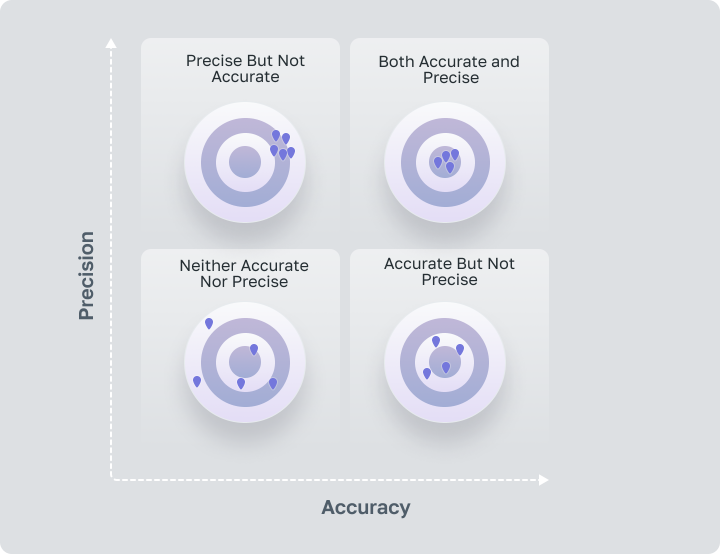
To visually see accuracy and precision, imagine a target board where accuracy represents how close the shots are to the bullseye (the true value), and precision represents how tightly grouped the shots are around each other.
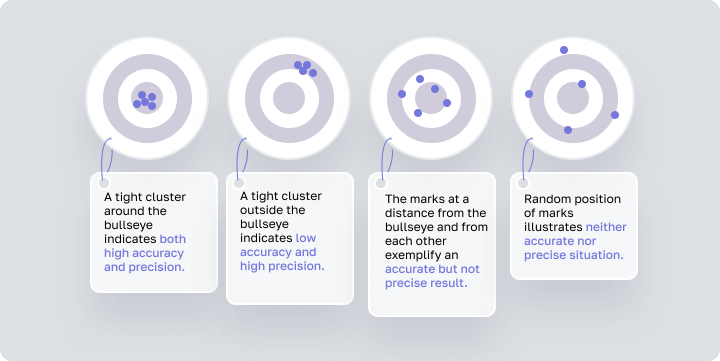
Interdependence and Balance
Accuracy and precision complement each other by forming a balanced approach to measurement quality. While accuracy ensures measurements are close to the true value, precision focuses on the consistency of results. Achieving both enhances confidence in data reliability. Together, they offer a comprehensive understanding of measurement quality.In the digital industry, the interdependence and balance of accuracy and precision are evident in various aspects, such as software development, data analysis, and user experience design.
In software development, accuracy ensures that codes and algorithms perform as intended, producing the desired outcomes. For example, in the development of a financial software application, accurate calculations are critical for processing transactions and generating reports with precision. A balance between accuracy and precision is achieved by rigorously testing the software to ensure that it produces accurate results (correctness) consistently (precision) across various scenarios.
In user experience (UX) design, accuracy and precision play a role in creating interfaces that meet users’ needs and expectations. For example, in designing a mobile app interface, accurate placement of interactive elements (such as buttons and menus) ensures a seamless user experience, while precise alignment of elements enhances the visual appeal and usability of the interface. Achieving a balance between accuracy and precision in UX design involves conducting user testing to validate design decisions and iterating based on user feedback to refine both the accuracy of functionality and the precision of user interactions.
Striking a balance between accuracy and precision requires careful calibration, quality control, and data analysis techniques, ultimately enhancing the credibility and utility of measurements in various applications.
Accuracy vs. Precision: Which is More Crucial?
The Debate on Importance
In the debate on accuracy versus precision, proponents of accuracy argue that it directly reflects correctness and reliability of measurements, crucial for making informed decisions.
Conversely, advocates for precision emphasize its role in ensuring consistency and reproducibility, which are fundamental for quality control and process optimization.
Ultimately, striking a balance between accuracy and precision is vital, as both contribute to the overall reliability and utility of measurements in different contexts.
Contextual Importance
In scientific research, accuracy is paramount for obtaining reliable results and drawing valid conclusions. Conversely, in manufacturing and engineering, precision holds greater importance to ensure consistent product quality and adherence to specifications.
In fields like medicine and finance, both accuracy and precision are critical: accuracy ensures correct diagnoses or financial predictions, while another this concept ensures reproducibility and consistency in treatment or investment outcomes.
So, the contextual importance of accuracy and precision varies based on the specific requirements and objectives of each application or industry.
Achieving a Balance
To achieve a balance between accuracy and precision in projects, start by clearly defining project goals and requirements. Select appropriate measurement tools and techniques that offer both accuracy and precision suitable for the project’s needs. The easiest way to achieve this balance is to use quality work planning and team management tools. For example, Worksection is effective for different companies and teams.
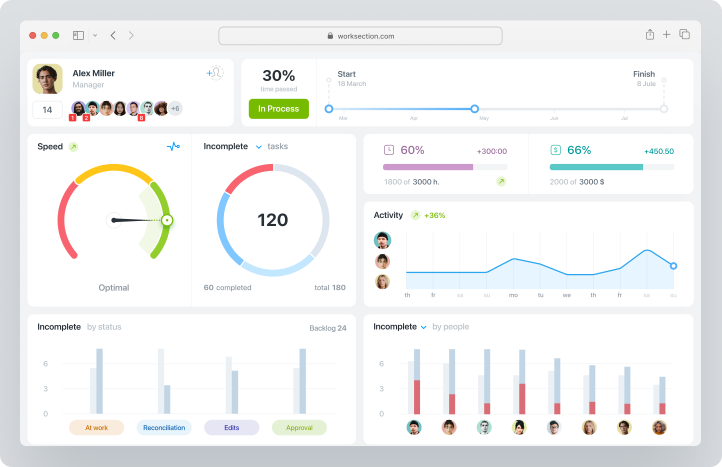
Worksection provides a comprehensive solution, offering tools for regular instrument calibration to uphold accuracy, as well as facilitating the implementation of quality control measures to bolster precision. It also includes features to minimize human errors and optimize measurement processes.
Furthermore, Worksection simplifies thorough data analysis, enabling users to identify and rectify any disparities between accuracy and precision, thereby ensuring that both are optimized to effectively meet project objectives.
Conclusion
Summary of Key Points
In summary, we can conclude:
- Accuracy refers to how close a measurement is to the true or target value, while precision measures the consistency or reproducibility of measurements.
- While accuracy ensures correctness and reliability, precision ensures consistency and reproducibility.
- Both accuracy and precision are essential in various applications, but their relative importance varies depending on the context.
- Achieving a balance between accuracy and precision is crucial for ensuring reliable and informative measurements.
- Striking this balance requires clear project goals, appropriate measurement tools and techniques, regular calibration, quality control measures, thorough data analysis, and understanding the difference between accuracy and precision.
Ultimately, optimizing both accuracy and precision enhances the reliability, validity, and utility of measurements across different industries and projects.
Final Thoughts
Understanding the key features and differences between accuracy and precision is essential for practitioners across various fields. Accuracy ensures measurements are close to the true value, reflecting correctness and reliability. In contrast, precision emphasizes the consistency and reproducibility of measurements. Both concepts are indispensable, but their relative importance varies depending on the application.
In fields like finance and banking, accuracy is paramount due to the high stakes involved. Prioritizing accuracy ensures that financial records, transactions, and calculations are correct, providing confidence to customers, regulators, and stakeholders.
By understanding and applying accuracy and precision appropriately, practitioners can enhance the reliability, validity, and utility of measurements in their respective fields, ultimately leading to improved decision-making and outcomes.
